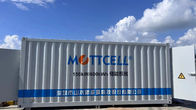Mottcell lithium battery: the winding and lamination of lithium ion battery assembly process
2022-07-18
The assembly of a lithium-ion battery usually refers to the process of assembling the positive and negative electrode sheet, diaphragm, pole ear, shell and other components into a battery. The assembly process can usually be divided into winding and lamination, assembly, welding, and other processes. Rolling and lamination are the process of making a positive and negative electrode sheet with a polar ear welded on the fluid collector into a positive electrode- -square or cylindrical core structure of the positive electrode-diaphragm-negative electrode structure.
Winding is usually the first pole ear with ultrasonic welding welded to the fluid collection, the positive electrode piece uses aluminum electrode ear, the negative electrode uses nickel electrode ear, and then the positive and negative electrode piece and diaphragm are arranged in accordance with the sequential positive electrode-diaphragm-negative electrode-diaphragm, and then assembled into a cylindrical or square cell through winding, as shown in Figure 1.
The lamination is usually a process of collecting fluid as the lead pole ear, and forming the positive and negative electrode plate and the diaphragm in the order of the positive electrode, the diaphragm and the negative electrode. The lamination process is shown in FIG. 2. The lamination mode includes both the direct lamination type of the diaphragm cut off and the folding type of the Z-shaped lamination type where the diaphragm is not cut off.
The specific process requirements for winding and lamination are as follows:
The ① negative electrode active substance coating can wrap the positive electrode active substance coating to prevent the production of lithium precipitation. For the winding cell, the width of the negative electrode is usually 0.5~1.5mm wider than the positive electrode, and usually 5~10mm longer than the positive electrode, and the length and width of the negative electrode are usually greater than the positive electrode 0.5~1.0mm. The size of the negative maximum is related to the process accuracy of the winding and lamination. The higher the accuracy, the smaller the length and width can be set aside.
The ② diaphragm is between the positive and negative electrodes and can separate the positive and negative electrodes completely, and it is longer and wider than the negative electrode electrodes: for the coil cell, the width of the diaphragm is usually 0.5~1.0mm wider than the negative electrode, and the length is usually 5~10mm longer than the negative electrode; for the laminated cell, the length and width of the diaphragm is usually 1~2mm greater than the negative electrode. The specific length of the diaphragm is related to the design of the electric cell structure.
③ winding core requires the tightness of the pole coil moderate, too loose waste of space, too tight is not conducive to the electrolyte infiltration, but also to avoid the cell spiral; the stack core requires the pole and diaphragm stack high uniformity, the assembly position of the pole ear and other parts to be accurate, so as to reduce the risk of space waste and safety risks.
④ winding and lamination process should prevent the pole damage, keep the pole edges flat, no burr.
(3) The winding and lamination have their own advantages using the overall positive and negative electrode winding assembly, usually has the advantages of high automation, high production efficiency, stable quality; but using a single electrode ear, high internal resistance, is not conducive to large current charge and discharge; and the winding cell Angle, resulting in low utilization rate of square battery space. So winding cells are usually used in small, conventional square batteries and cylindrical batteries.
Each pole piece of the laminated cell has a pole ear, the internal resistance is relatively small, suitable for high current charge and discharge; and the laminated cell space utilization rate is high. But the lamination process is relatively cumbersome, and there are multiple pole ears, prone to virtual welding. Therefore, laminated cells are usually suitable for large square batteries, but also can be used for ultra-thin batteries and special-shaped batteries.
-
2022-06-28
-
2023-02-18
-
2022-02-18
-
2022-02-18



